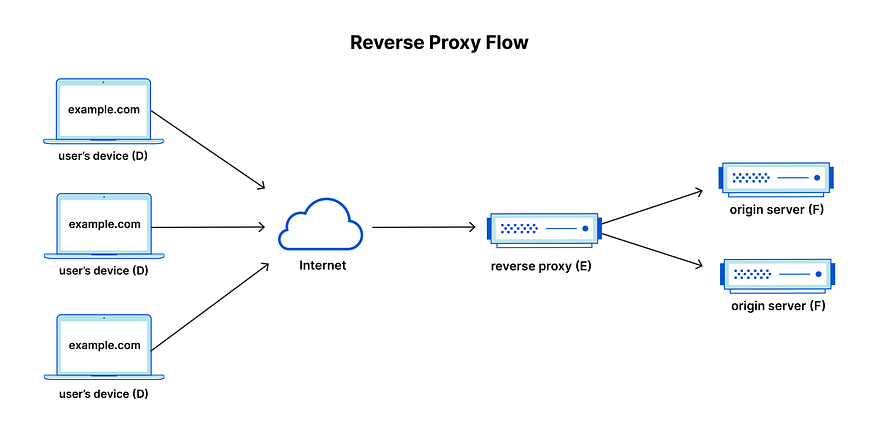Before delving into the intricacies of forward and reverse proxy servers, it's essential to grasp the concept of a proxy server and how it differs from a typical server.
Think of a proxy server as your waiter; it serves as an intermediary between you and the chef. While it doesn't know how to prepare the dish, it knows that you want to order it. In this analogy, you are the client, the chef is the person or the actual server preparing your food, and the proxy server acts as your waiter.
In more formal terms:
The distinction between different types of proxy servers, like forward and reverse proxy, depends on how you intend to use them and your specific requirements. Let's explore these types in detail.
Forward Proxy
A forward proxy server operates as an intermediary between a client and the internet. When a client requests a resource, the forward proxy server retrieves the resource on the client's behalf and forwards it back to the client.

Forward Proxy Server. Image Credit: Cloudflare
You might wonder, why use a proxy at all? Why not directly request resources from the server? There are several reasons to use a forward proxy server, including:
- Better control over internet usage: A forward proxy server can permit or deny access to specific resources, content, or services based on predefined rules. This is valuable for organizations monitoring and regulating employees' or students' internet activities, or for parents restricting their children's online exposure.
- Bandwidth savings and improved speed: By caching frequently accessed web pages and resources, a proxy server reduces network traffic, resulting in faster loading times. This is beneficial for large networks with limited bandwidth or users aiming to save data and access content more quickly.
- Enhanced privacy and security: A proxy server can hide a user's IP address and other identifying information from the resource server, making it more challenging to track or target the user. It can also encrypt the user's web requests and responses, preventing interception or tampering. This is advantageous for users wanting to safeguard their personal data, identity, or location from prying eyes or malicious actors.
- Bypassing censorship: A proxy server helps users access web content and services blocked or restricted by their network, ISP, government, or country. It achieves this by routing requests through a different location or IP address not subject to the same limitations. This is beneficial for users seeking more online freedom, diversity, and democracy.
Reverse Proxy

Reverse Proxy Server. Image Credit: Cloudflare
In contrast, a reverse proxy server positions itself between the internet and web servers. It receives requests from clients and directs them to the appropriate server based on various factors, such as load balancing algorithms or server availability. This even distribution of incoming traffic enhances the scalability and reliability of web applications.
Additionally, reverse proxy servers can provide caching capabilities. By caching static content, such as images or CSS files, the reverse proxy server can serve these resources directly to clients, eliminating the need to forward requests to backend web servers. This significantly reduces response times and enhances the overall performance of the web application.
Another critical feature of a reverse proxy server is SSL termination. When a client requests a secure connection (HTTPS), the reverse proxy server can handle the encryption and decryption processes, relieving backend servers from this resource-intensive task. This not only improves the web application's performance but also simplifies SSL certificate management.
Some examples of reverse proxy servers include:
- Nginx: Nginx is a highly performant open-source web server that can also function as a reverse proxy. It supports various protocols, load balancing algorithms, caching mechanisms, and security features.
- Varnish: Varnish is an open-source HTTP reverse proxy with a built-in cache engine, designed for accelerating web applications.
- Apache Traffic Server: Apache Traffic Server is an open-source HTTP reverse proxy and cache server, capable of handling millions of concurrent connections and various protocols.
- Istio: Istio is an open-source service mesh that enhances microservice communication with features like service discovery, load balancing, traffic routing, and more.
Conclusion
In summary, both forward and reverse proxy servers play pivotal roles in enhancing the security, privacy, and performance of internet communication. While a forward proxy server focuses on protecting a client's identity and caching resources, a reverse proxy server excels in distributing traffic, caching content, and handling SSL termination for web applications.

